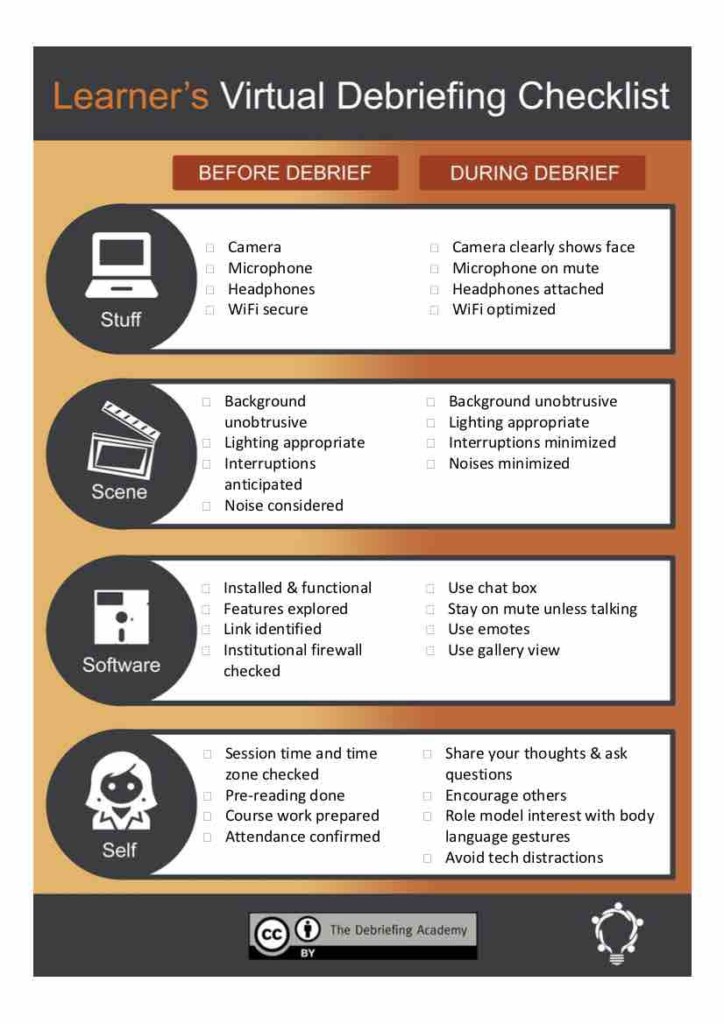Tips for Optimizing Virtual Debriefings in the Era of COVID-19, From The Debriefing Academy
Virtual debriefings in healthcare education can be especially challenging. The COVID-19 pandemic has forced many healthcare simulation programs to move their educational curriculum to the online virtual environments. As a result, clinical simulation educators are conducting more virtual debriefings, which involves facilitating conversations via web-based teleconferencing platforms. Virtual debriefings introduce a distinct set of challenges that may make it more difficult for medical simulation educators to promote reflective discourse during the debrief. Here, faculty from the Debriefing Academy offer five practical tips to get the most out of virtual debriefings. Make sure to download the Virtual Debriefing Checklist shared here too!
1 – Set expectations
For many learners, participating in debriefing via a web conferencing platform is a complete new and foreign experience. Setting clear expectations prior to the debriefing helps to establish a shared understanding of learner (and facilitator) roles. Facilitators should provide an overview of the web conferencing software features, encourage learners to keep video on at all times, discuss rules for turn taking (i.e. raising hand feature), provide guidelines for when to mute/unmute, and advise learners to call in from a quiet, private space (Cheng et al, 2020). When co-facilitating, educators should meet ahead of time to review the same expectations, along with other items critical to effective co-facilitation (e.g. debriefing framework, rules of engagement, learning objectives, personal learning goals etc).
Sponsored Content:
2 – Make use of technology
While virtual debriefing can potentially increase educator mental workload, current software provides many features than can help to enhance the online learning experience. The use of the gallery or grid feature allows multiple learners to be visible on the screen all at once, which is critically important for debriefing. The chat box is an alternative mode of communication which can be particularly helpful if used selectively (e.g. crowdsourcing opinions during select portions of the debriefing). Screen-sharing provides opportunity to pull up and share resources during the debriefing, while the whiteboard feature gives educator a tool to share notes visually.  3 – Focus on the explicit
3 – Focus on the explicit
Establishing psychological safety is paramount to ensuring learners feel ‘safe’ enough to share their honest thoughts, feelings, and reflections during virtual debriefings. In a recent paper, Kolbe et al describe both implicit (i.e. non-verbal, subtle) and explicit (i.e. verbal, overt) strategies to build and maintain psychological safety in debriefing (Kolbe et al, 2020). Many non-verbal cues are difficult to pick-up and thus less effective in the online environment, such as eye contact and body language. For this reason, we encourage educators to focus more on using explicit, verbal strategies to maintain psychological safety. For example, educators may verbally acknowledge and validate learner contributions more frequently during virtual debriefings than they typically would during in-person debriefings.
4- Do what you do best
Sponsored Content:
Virtual debriefings still require structure. Educators should stick with the debriefing framework they are most comfortable with as this will help to reduce mental workload. Learners are more likely to be familiar with the structure of conversation if the educator adheres to the same debriefing framework, which in turn may promote more effective reflective discourse (Cheng et al, 2020). Blending conversational strategies will allow educators to tailor their debriefing method to the needs of the learners (Eppich et al, 2015).
5 – Practice what you preach
To assist with implementing the above strategies, we recommend using a learner virtual debriefing checklist (see Figure), which outlines things that learners can do before and during the debriefing to enhance the learning experience. While the checklist is helpful in setting expectations, educators bring these behaviors to life by modeling them during the debriefing. For example, the checklist encourages learners to avoid having other distractions (e.g. cell phone, email) during the debriefing; educators should be held to the same standard, which will reinforce these behaviors amongst learners.
Recent HealthySimulation.com Adam Cheng, MD Webinar Furthers Discussion of Virtual Debriefing
In his recent HealthySimulation.com webinar entitled “Virtual Debriefing in the Age of COVID-19“, Dr. Adam Cheng discusses how the Communities of Inquiry conceptual framework can be used as a useful structure to organize practical guidance for conducting virtual debriefings, and highlight practical strategies to promote effective virtual debriefings — especially now during the Coronavirus pandemic. Many simulation programs have recently shifted towards providing remote simulations with virtual debriefings. Virtual debriefings require simulation educators to facilitate discussions through web-based videoconferencing platforms. Facilitating debriefings through a computer interface introduces a unique set of challenges. Simulation educators require practical guidance to support meaningful virtual learning in the transition from in-person to virtual debriefings.
Additional Debriefing Courses Available From The Debriefing Academy
To learn more about virtual and in-person debriefing, check out the Master Debriefer Course (Virtual Edition), which provides the advanced content, strategies and tools necessary to transform debriefing conversations into vehicles of change within healthcare environments. The Master Debriefer Course (Virtual Edition) is an immersive and interactive 7-week online course taught by leading debriefing experts from around the world. The course focuses on improving debriefing skills by weaving through key elements of debriefing practice, including: psychological safety, cognitive load, blended method debriefing, co-debriefing, learner-centered debriefing, peer coaching, difficult debriefing, and virtual debriefing.
Visit The Debriefing Academy Website to Learn More!
Sponsored Content:


















